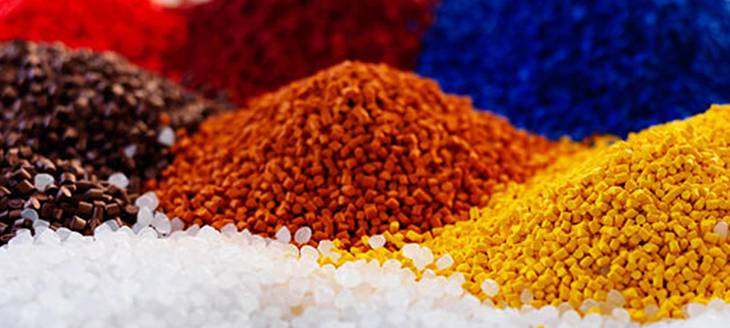Top 5 Plastic Resins Used in Injection Molding
With hundreds of commodity and engineering resins available on the market today, the material selection process for plastic injection molding can often seem daunting at first. However, it is much easier to pick a plastic when you look into the overall characteristics that these plastics have to offer.
Below are the five popular types of resins used for plastic injection molding:
ABS
ABS (Acrylonitrile Butadiene Styrene) is used in a wide range of industries, such as manufacturing, automotive, medical, and marine. It is an ideal material for structural applications when impact resistance, strength, and stiffness are required. It is widely used for machining pre-production prototypes since it has excellent dimensional stability and is easy to paint and glue.
Characteristics:
- Structural strength & stiffness
- Chemical-resistant
- Excellent high & low-temperature performance
- Great electrical insulation properties
Some factors to consider while using ABS is that molding it at a high temperature improves the gloss and heat resistance of the product whereas molding at a low temperature is where the highest impact resistance and strength are obtained.
Acetal
Acetal is a high-performance engineering polymer often used for parts that would otherwise be made of metal. All acetals are strong and durable making them apt for mechanical parts like gears and chain links. They are ideal for automotive, and construction applications.
Characteristics:
- Abrasion-resistant
- Low moisture absorption
- High strength & stiffness
- Creep resistant
Few things to keep in mind before opting for Acetal. They are affected by strong acids or oxidizing agents but have high resistance to most chemicals.
Polypropylene
Regarded as one of the lightest and most versatile polymers, Polypropylene (PP) is made from the combination of propylene monomers. It is used in a variety of applications to include packaging for consumer products, household products, plastic parts for various industries including the automotive industry.
Characteristics:
- High flexural strength
- Insulation
- Low coefficient of friction
- Low density
- Heat-resistant
Polypropylene’s characteristics make it ideal for tough, robust products ranging from protective car bumpers to life-saving medical tools. If you are opting for polypropylene, keep in mind that they are flammable and degraded by UV radiation.
High Impact Polystyrene
High Impact Polystyrene (HIPS) provides tough, low-cost performance and highly customizable surfaces: It can be printed, glued, bonded, and decorated easily. Due to the versatile nature of this material, they are suitable for applications in the cosmetics, display, food, medical, horticultural, industrial and custom thermoforming markets.
Characteristics:
- High tensile strength
- Electrical insulation
- Impact-resistant
- Great dimensional stability
A major advantage is that it can be re-molded over and over again, which makes it environmentally friendly as it can always be recycled.
Low-Density Polyethylene
As the name suggests, Low-Density Polyethylene (LDPE) has a low density which means it has less mass compared to its volume. It is characterized by its short and long chain branching which gives it good clarity and processability. LPDE can be found in many consumer goods, electronics, housewares, and medical products.
Characteristics:
- Moisture-proof
- Reduced weight
- Robust
- Low crystallization capacity
Keep in mind that it is difficult to bond with other polymers, and should not be used in harsh weather or high-temperature applications.
Each type of plastic has their own properties, and it is extremely important to look at the overall defining characteristics before choosing a plastic for injection molding. If you believe a plastic is falling short of some properties, there is always fine tuning through the use of additives and fillers to get the material properties just right – that’s how you end up with over 85,000 types of plastics.
Leave a Reply Cancel reply
Recent Posts
- Understanding The Materials That Are Used To Build Plastic Toys
- All You Need To Know About Food-grade Plastics
- A Glance At The Materials That Boost The Performance Of Plastics
- Understanding The Importance Of Exploring New Business Opportunities In The Plastic Industry
- Understanding The Importance Of Investing in R&D For The Plastic Industry
Categories
- 3D Printing
- AIPMA
- Automation
- Automobile Sector
- Bio Plastics
- Environment
- Innovations In Recycling
- Latest Innovations
- Molds & Dies
- News
- Packaging Industry
- Plastic
- Plastic Application
- Plastic Industry
- Plastic Market
- Plastic Myths
- Plastic News From The World
- Plastic Packaging
- Plastic Products
- Plastic Recycling
- Plastic Solar Cells
- Plastic Toys
- Plastic Waste
- Plastic World
- Plastics
- Plastics And Their Applications
- Plastics In Agriculture
- Plastics In Healthcare
- Plastics In Medical Industry
- Plasticulture
- Processing Machinery
- Recycling Machines
- Robotics
- Uncategorized
- Virtual Reality
Archives
- November 2023 (3)
- October 2023 (2)
- September 2023 (3)
- August 2023 (3)
- July 2023 (3)
- June 2023 (3)
- May 2023 (2)
- April 2023 (2)
- March 2023 (2)
- February 2023 (2)
- January 2023 (2)
- December 2022 (3)
- November 2022 (1)
- October 2022 (1)
- September 2022 (2)
- August 2022 (1)
- July 2022 (3)
- May 2022 (3)
- March 2022 (2)
- February 2022 (1)
- January 2022 (1)
- September 2021 (2)
- August 2021 (3)
- July 2021 (4)
- June 2021 (4)
- May 2021 (3)
- April 2021 (2)
- March 2021 (4)
- November 2019 (8)
- October 2019 (8)
- September 2019 (8)
- August 2019 (8)
- July 2019 (8)
- June 2019 (8)
- May 2019 (8)
- April 2019 (8)
- March 2019 (8)
- February 2019 (11)
- January 2019 (8)
- December 2018 (8)
- November 2018 (12)
- October 2018 (12)

